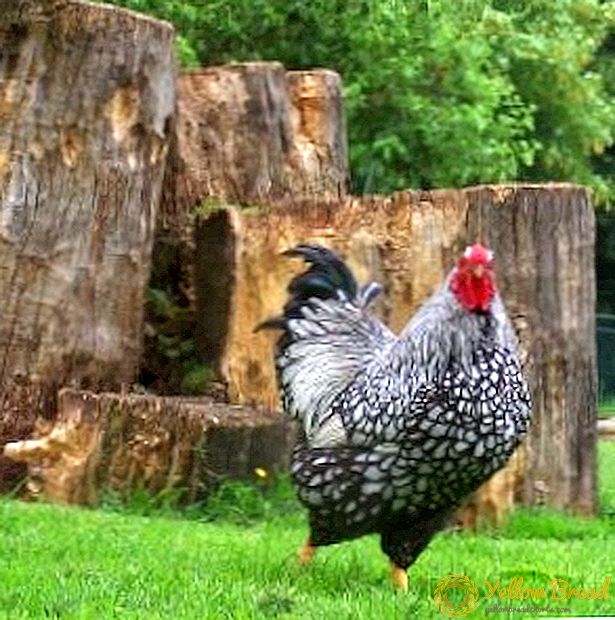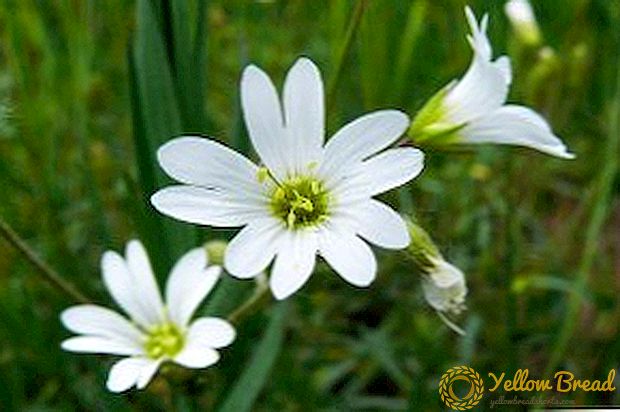 Apricot "Black Prince" is not familiar to all gardeners, but is quickly gaining popularity. Variety - a hybrid of apricot, cherry plum and plum, according to the breeders, it appeared as a result of random pollination of apricot cherry plum. Subsequently, it was slightly improved by adding the characteristic features of the plum.
Apricot "Black Prince" is not familiar to all gardeners, but is quickly gaining popularity. Variety - a hybrid of apricot, cherry plum and plum, according to the breeders, it appeared as a result of random pollination of apricot cherry plum. Subsequently, it was slightly improved by adding the characteristic features of the plum.
- Apricot "Black Prince": what the tree and fruit looks like
- Conditions for planting and growing
- Landing dates (weather conditions)
- Choosing a place to plant apricot
- Features of growing apricot "Black Prince": how to plant a unique plant
- Preparing a pit for planting
- The scheme and technology of planting apricot "Black Prince"
- Rules for the care of the "Black Prince" in the garden
- What you need to know about watering plants
- Organic and mineral fertilizers for apricot
- Pruning varieties
- Pest and disease prevention
- Apricot "Black Prince": the pros and cons of variety
Apricot "Black Prince": what the tree and fruit looks like
Apricot "Black Prince" is described as a small tree or a tall bush. It has a narrow and not too thick crown, the skeletal structure of the branches, which may have spines. The bark of the tree casts a dark green shade.The foliage on the short and thin stem is often oval in shape, the edges of leaf blades with teeth.
"Black Prince" blooms in white or light pink flowers. The fruits ripen in August, depending on the region at the beginning, middle or at the end of the month. Hybrid of apricot and plum "Black Prince" is not the only variety of black apricots, but differs from other varieties with the largest fruits.  In regions with a temperate climate, the weight of the fetus is 45-60 grams, in the southern regions it reaches 90 grams of weight. The skin of the fruit is dark burgundy, the flesh is most often the color of red wine, juicy and ryhlovaty. The bone is easy to separate from the pulp, it is small. The taste of this hybrid is pleasantly refreshing, tart and sour. Black apricot pollinator can be apricot, plum, cherry plum, turni and other varieties of black apricot, although the culture is self-pollinated.
In regions with a temperate climate, the weight of the fetus is 45-60 grams, in the southern regions it reaches 90 grams of weight. The skin of the fruit is dark burgundy, the flesh is most often the color of red wine, juicy and ryhlovaty. The bone is easy to separate from the pulp, it is small. The taste of this hybrid is pleasantly refreshing, tart and sour. Black apricot pollinator can be apricot, plum, cherry plum, turni and other varieties of black apricot, although the culture is self-pollinated.
Conditions for planting and growing
The growing conditions of the “Black Prince” are practically the same as those of an ordinary apricot. There are several distinctive recommendations and tips for caring for the abrissive "Black Prince".
Landing dates (weather conditions)
The best period for planting apricot is spring, and before the buds bloom, the weather is preferably cloudy or with drizzling rain. Spring planting gives a 100% survival rate of seedlings.
Landing is undesirable in the fall, especially in cold climates. You can spend the autumn planting in the southern regions in September, so that the sapling has a couple of months left to adapt. Autumn planting of one hundred percent rooting does not guarantee.
Choosing a place to plant apricot
 Apricot "Black Prince" - a sun-loving variety, it also needs protection from drafts and strong wind. The best place for landing will be the southern side of the site, preferably protected by a wall of a house or fence.
Apricot "Black Prince" - a sun-loving variety, it also needs protection from drafts and strong wind. The best place for landing will be the southern side of the site, preferably protected by a wall of a house or fence.
The tree is unpretentious to the choice of soil, but does not tolerate excess moisture: groundwater should not pass close to the surface.
Features of growing apricot "Black Prince": how to plant a unique plant
Saplings of the "Black Prince" for a successful fit and care, not burdened with problems, you must carefully inspect before buying. It must be strong plants with no visible damage, with a developed root system. The roots must be in a wet, earthy coma.
Preparing a pit for planting
 The pit for planting is prepared in the fall, sizes approximately 80x80x80 cm, it is necessary to lay drainage on the bottom so that the moisture does not stagnate, and to drive a peg (above the surface of the pit it should stick out half a meter). The earth that was dug out of the pit is mixed with peat (one second from a part of the earth), 0.5 kg of superphosphate and 2 kg of ash are added. The mixture is laid back into the pit and left there until spring for precipitation.
The pit for planting is prepared in the fall, sizes approximately 80x80x80 cm, it is necessary to lay drainage on the bottom so that the moisture does not stagnate, and to drive a peg (above the surface of the pit it should stick out half a meter). The earth that was dug out of the pit is mixed with peat (one second from a part of the earth), 0.5 kg of superphosphate and 2 kg of ash are added. The mixture is laid back into the pit and left there until spring for precipitation.
The scheme and technology of planting apricot "Black Prince"
In the spring, in the sagging pit, a depression is made under the size of the roots of an apricot seedling “Black Prince”.A seedling is dipped into a clay mash and rooted in a planting pit so that the roots do not bend and the root neck is 5 cm above the surface of the pit. Then sprinkle with soil, lightly tamp and pour the seedling. When moisture is absorbed, the soil will squeeze a little, the root neck of the plant will take the right place. A sapling after all procedures must be tied to a peg.
Rules for the care of the "Black Prince" in the garden
"Black Prince" is undemanding in care, the procedures are the same as for the other fruit crops: watering, feeding and pruning. For winter, it is desirable to wrap young trees at the base of the trunk. In a snowless winter, first-year seedlings can be very cold. In the spring, the trunk of the tree must be processed with lime.
What you need to know about watering plants
 Black apricot "Black Prince" does not tolerate drought, but does not tolerate overflow. In the process of vegetation, the tree needs frequent, but moderate in the dosage of watering. In summer, watering is less frequent. In the autumn after harvesting, watering is significantly reduced, the moisture gives the young shoots the strength to grow, but they do not have time to get stronger by the winter.
Black apricot "Black Prince" does not tolerate drought, but does not tolerate overflow. In the process of vegetation, the tree needs frequent, but moderate in the dosage of watering. In summer, watering is less frequent. In the autumn after harvesting, watering is significantly reduced, the moisture gives the young shoots the strength to grow, but they do not have time to get stronger by the winter.
Organic and mineral fertilizers for apricot
"Black Prince" has one feature in growing: the grade does not like nitrogen fertilizers, it is bad for excess fertilizers. The plant needs very moderate organic supplements during the growing season and mineral with phosphorus and potassium during the formation of the fruit, also in moderate dosages.
Pruning varieties
Pruning "Black Prince" is rarely done.: The variety has a not very branched and thickened crown. In the spring, before the formation of buds, sanitary pruning of damaged or frozen branches is carried out. Removed broken or with signs of disease shoots. In the fall, the tree is also inspected and cleaned from damaged branches, so that they do not take food from healthy shoots in winter. Formative pruning is carried out as needed, shoots that grow inside the crown are removed, weaker ones that interfere with the growth of healthy strong branches. 
Pest and disease prevention
Apricot variety "Black Prince" is considered one of the most disease-resistant apricot trees, but also precautionary measures will not damage it.
The pledge of health is cleanliness, remove the tree trunk from plant residues for the winter.In the remaining on the ground fruits and branches, parts of the bark like to settle in the winter for both the larvae of insect pests and the spores of various infections. It is necessary in the fall and spring to cut off weak branches, smearing the cut areas with garden pitch to prevent infection, the stem of the tree must be covered with lime. During the season it is advisable to weed the tree trunk from weeds. Inspect from time to time parts of the tree, in time to notice a possible illness or parasites.
 At the first symptoms of a disease or insect invasion, take measures: fungicides need to be treated for diseases (many of them are universal), insecticides will help against insects.
At the first symptoms of a disease or insect invasion, take measures: fungicides need to be treated for diseases (many of them are universal), insecticides will help against insects.
In the fight against insects also use folk methods: decoction of marigolds, decoction of onion peel, decoction of tops of tomatoes and others.
Apricot "Black Prince": the pros and cons of variety
The summer residents, who have already harvested the first harvest of apricot "Black Prince", were satisfied and ready to share tips on how to grow this unusual variety. Culture like the fact that it does not require much effort either in landing or in the subsequent care. The advantages of the variety include winter hardiness, yield, large fruits and the pleasant taste of these fruits. Many emphasize the decorativeness of the tree during flowering.
The undoubted advantage of the Black Prince is its resistance to the diseases common among the stone trees: moniliosis, phytosis and cytosporia. The positive point is and self-pollination ability. Gardeners also note the late flowering of apricot, which does not allow the flowers to die in case of return frosts.  The disadvantages of black apricot varieties include inability to transport, fruits are often damaged. In addition, they can not be overripe, otherwise the skin is cracked, the crop is harvested immature. Despite winter hardiness, tree trunks need to be covered with mulch, most often in this variety the roots are frozen.Also a disadvantage is the appearance of spines on the trunk in the sixth year of life.
The disadvantages of black apricot varieties include inability to transport, fruits are often damaged. In addition, they can not be overripe, otherwise the skin is cracked, the crop is harvested immature. Despite winter hardiness, tree trunks need to be covered with mulch, most often in this variety the roots are frozen.Also a disadvantage is the appearance of spines on the trunk in the sixth year of life.
In conclusion, I would like to add a few laudatory reviews to the address of the "Black Prince" from housewives and lovers of sweet preservation. From this grade it turns out incredibly aromatic and tasty, with spicy sourness jam, but do not come off from compotes and marmalade.






